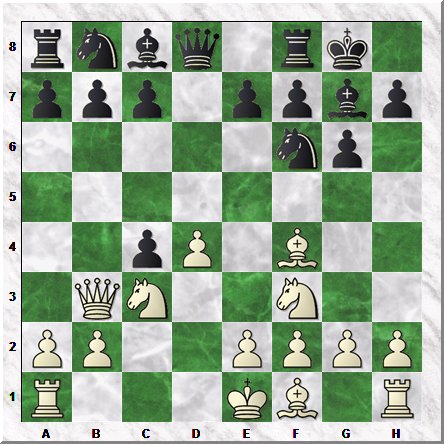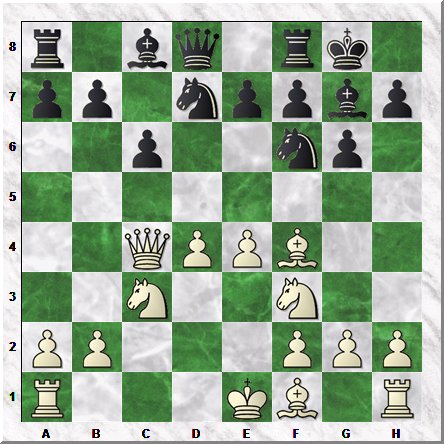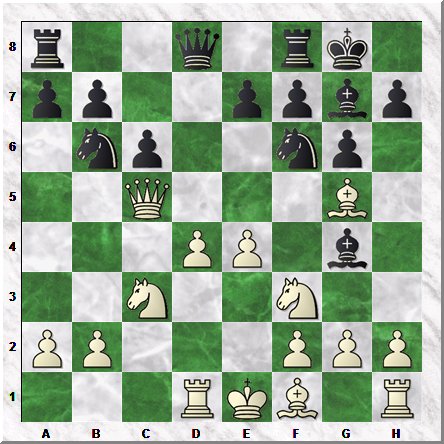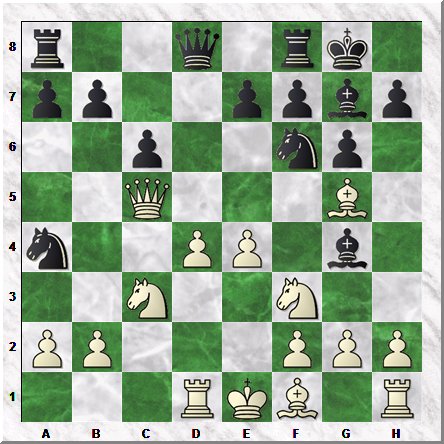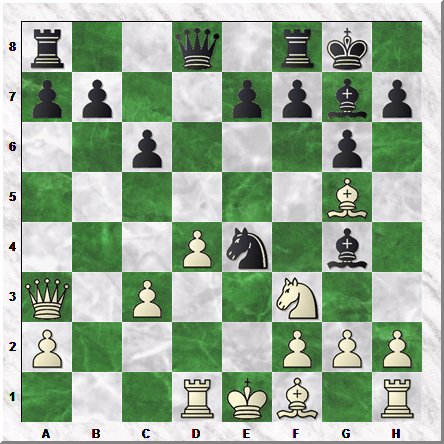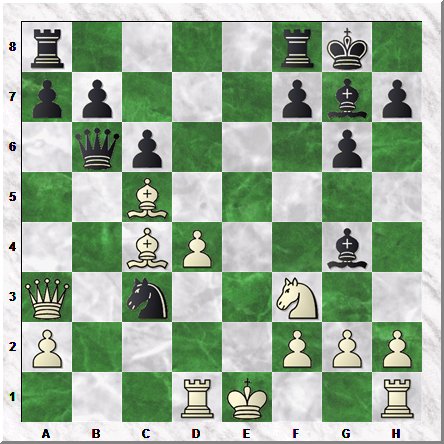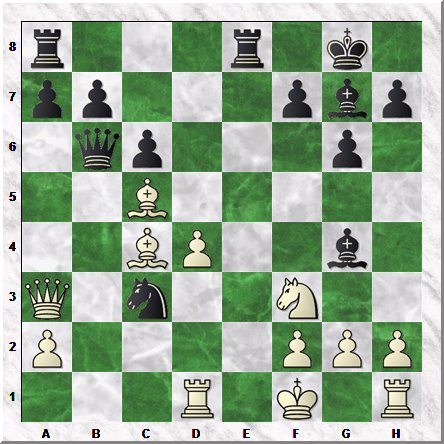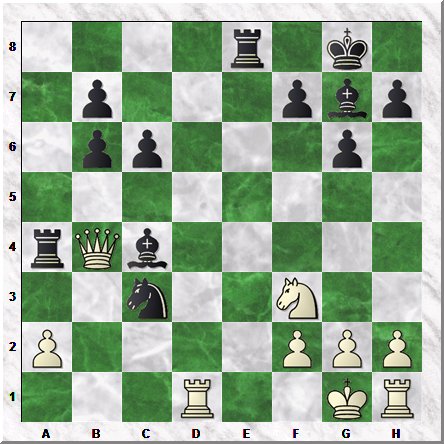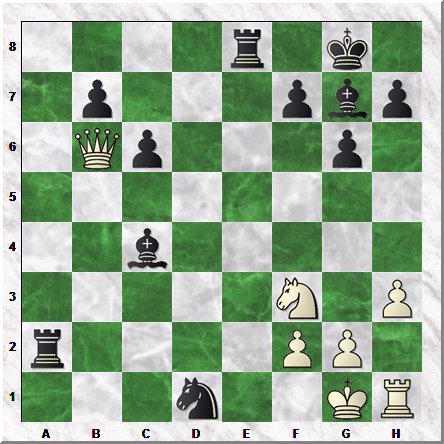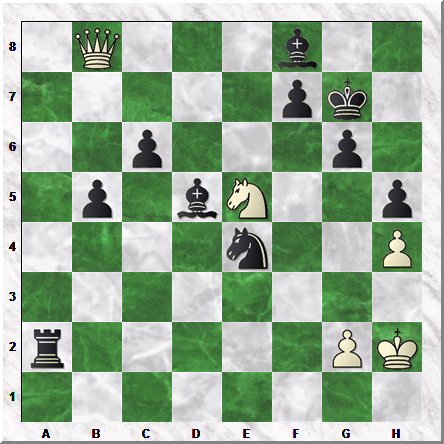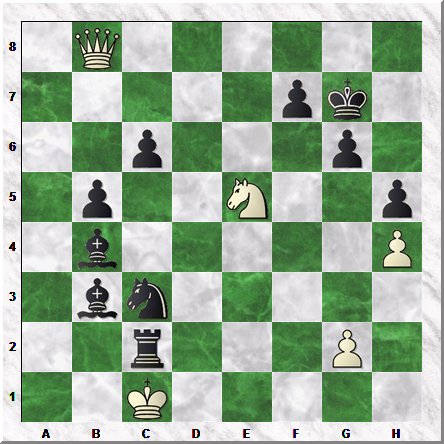All
the |
(Navigation bar
directly below.)
*******
© A.J. Goldsby, 2015.
(All rights reserved.)
****************
Click HERE
to see my
Chess Items.
****************
****************
Buy a book
from Amazon.com
(And help me out as well!)
****************
Click HERE
...
to see a list of the businesses that help to sponsor all of
my chess efforts.
The Game of The Century
|
|
Click HERE to see an explanation of the symbols that I commonly use when I annotate any chess game. Click HERE to replay this game. (Click HERE to see a "star-dot-pdf" / Adobe copy of my analysis.) Click HERE to see my video channel on the "You-Tube" channel. (Click HERE to see my YT video on this game.) |
Donald Byrne - Robert J. Fischer;
|
|
|
[A.J.G.]
(This was ... originally ... ) A BAG-lite game. January 10th, 2014.
{A new look at this classic and historic chess contest ... which, I
believe, won a brilliancy prize.
I went back to a totally clean sheet of paper for this version of
annotation, and I tried to
forget everything I knew about this game.
The chess engines were the leader here ... and I tried to always
thoroughly
follow their lead.}
Another thing that gave added impetus to this project was that one of my PCC students and I looked at this game on their laptop in the fall of 2013. (I bought a spiral-bound notebook and I recorded just about all of our observations.)
Nearly 20 years has elapsed, (or - in some cases - even more time than this ...); since the first time that I began to use chess engines to examine this game ... they have become much stronger, (exponentially so); in the last 5-10 years. Due to this advancement in the overall technology, I thought it would be fun to take yet another look at it. (I will stick to the lines of the various chess engines.)
***************************************************************************************************************************************
Another under-appreciated fact was that, in 1956, Bobby Fischer
was a virtual nobody.
(At that particular point in
time.)
However, his opponent was one of
the top players in the USA ... and #65 in the whole world!!!!!
(See just below.)
#1.) Samuel Reshevsky (2752)
#2.) Larry Evans (2640)
#3.) Arthur
Bisguier (2612)
#4.) Donald Byrne (2589)
[ Notice that Donald ... in those days ... was even higher rated than his (later) much more famous older brother!!!!!!
Of course, in 1974, the elder R. Byrne went all the way to the quarter-finals of the Candidates
Matches, losing only to GM Boris
Spassky.
{Source
(for ratings): The CM
website.} ]
***************************************************************************************************************************************
I have analyzed the opening before, I don't think that theory has changed that much since I first examined this game.
(The game begins as a Reti, and then it will transpose to a Grunfeld, Russian System.)
1.Nf3 Nf6; 2.c4 g6; 3.Nc3 Bg7; 4.d4 0-0; 5.Bf4 d5; 6.Qb3 dxc4; ('!')
6...c7-c6; is the choice advocated by the new (CB) "Power-Book."
|
|
rnbq1rk1/ppp1ppbp/5np1/8/2pP1B2/1QN2N2/PP2PPPP/R3KB1R w KQ - 0 7
However, Fischer's move is much sharper and leads to a different type of game.
7.Qxc4 c6[]; ("Box." No choice.)
One author actually criticized this move, (at the time that this game was first played); but the engines all agree that it was 100% best and/or forced.
8.e4 Nbd7; (Maybe - '!?')
This is a solid move ... and I do not believe that there is anything fundamentally wrong with it.
However, I have to agree with many of the engines that 8...b5; was a slightly more active move for Black.
|
|
r1bq1rk1/pp1nppbp/2p2np1/8/2QPPB2/2N2N2/PP3PPP/R3KB1R w KQ - 0 9
One thing that Fischer had in common with Morphy as that if you got caught with your King in the center, they both could whip up a nice attack ...
almost out of thin air!
[ RR 8...b5; ('!') - Fritz 13. ]
9.Rd1, (Center.)
Most engines prefer Be2, yet this move (also) places Black under a great deal of pressure here.
[ An interesting line would be: RR
9.e5!? Nb6!; (hmm)
Seemingly best.
( 9...Nd5!?; 10.Nxd5 cxd5;
Now 11.QxP/d5, ('?') allows Black to play
the surprising shot of 11...NxP/e5! "=/+"
11.Qb3[] Qb6!; 12.Qxb6 axb6!; "<=>" )
10.Qc5!, (Best!?)
This seems to be the move indicated as being best by all of the engines here.
( RR 10.exf6!? Nxc4; 11.fxg7 Kxg7; 12.Bxc4 Bg4; "+/=" )
10...Nfd5; "~" (mostly unclear)
and Black may be slightly better in this position. ]
Now Black plays a pretty good move ... a young Bobby Fischer plays his Knight to the b6-square, in order to free his QB, with a gain of time. Some pundits (also) criticized this move as well, however, most engines confirm that it is ... (ABSOLUTELY!!!) the best move for Black in this particular position.
9...Nb6; ('!') 10.Qc5!, (Yes!)
Many of the authors/pundits heavily criticized this move ... (at the time when this game was first played); ... as being grossly bad or simply completely inferior. (I have always liked it and many of the better engines - today - also choose Qc5 for White in this position.)
[ RR 10.Qb3!? Nh5!; 11.Be3 Be6!; 12.Qa3 Qd6!; "=" ]
Now many of the engines will want to play ...Be6; or even ...a5; here. Yet I greatly prefer Fischer's move ... simply because it greatly cranks up the heat/pressure in this game.
10...Bg4!; 11.Bg5!?, ('?!'/'?')
White (also) plays a move with the deliberate intention of playing sharp and uncompromising chess. However, (today); there is no doubt that this move is an error, and allows a young Bobby Fischer a chance to play brilliantly.
I also wanted to share an interesting observation with you, and this is one you would not be aware of ... unless you have been using engines for more than 10-15 years. (At a minimum.) When the engines first came out, many of them wanted to play Bg5 here ... They also could think all day, and not discover anything wrong with Bg5. Now they immediately notice a fairly large downturn in the "scores" of the position and they also begin to see ...
almost immediately - the win for Black.
|
|
r2q1rk1/pp2ppbp/1np2np1/2Q3B1/3PP1b1/2N2N2/PP3PPP/3RKB1R b K - 0 11
The stage is now set for some of the greatest tactical shots ever played by ANY chess prodigy!
[ >/= 11.Be2!, "+/=" ]
11...Na4!!; (Maybe - '!!!')
(Super <nearly unbelievable?> chess!!!)
A young Bobby does not miss his chance to play a (very good) surprise move in this position.
(Students are routinely stunned and show obvious disbelief when I show them this particular bolt of chess lightning.)
|
|
r2q1rk1/pp2ppbp/2p2np1/2Q3B1/n2PP1b1/2N2N2/PP3PPP/3RKB1R w K - 0 12
I will also note that almost none of the students - that I ever studied this game with - will ever pick this move and will usually play something mundane like 11...Re8; in this particular position.
12.Qa3[], (Best/box/forced.)
Again, Byrne plays the best move here, yet many authors slammed Byrne for playing his Queen to "an inferior square" at this juncture in this game.
(Maybe 12.Qa3!)
[ White gets into more trouble with the capture on a4 ...
</= 12.Nxa4?! Nxe4!!;
13.Bxe7,
(*SIGH*) "Might as well."
{White does not really have a good move at this point.}
( Another possibility was: RR
13.Qb4!? a5;
14.Qxe7 Nxg5;
15.Qxg5 Re8+;
16.Kd2, ("Box?")
This was probably forced.
( Even worse would be:
</= 16.Be2? Qxg5;
17.Nxg5 Bxe2; '-+' )
16...Bxf3;
(Pawn-structure.)
17.Qxd8 Raxd8;
18.gxf3 Rxd4+;
19.Kc2 Rxa4; '-+' )
(Back to the main line of this whole variation.)
13...Nxc5!;
14.Bxd8 Re8+!;
15.Be2 Nxa4;
16.Bg5 Bxf3!;
17.gxf3 Nxb2;
18.Rd2 Nc4;
19.Rd1 h6;
20.Bc1 Rad8!;
"-/+" Black has a won game.
(Although the second player only has one Pawn, this must be an overwhelming
position for Black ... White's Pawn structure is in tatters, the 1st player's pieces
are in a state of confusion, and White's d-Pawn is probably doomed as well.)
]
Black's next move appears to strengthen White's center, but even in chess, appearances can be >>> (sometimes ... very) deceiving.
12...Nxc3!; 13.bxc3, Nxe4!;
Fischer does not hesitate to sacrifice. Meanwhile Byrne must either meet the challenge here ... or slink away in defeat.
|
|
r2q1rk1/pp2ppbp/2p3p1/6B1/3Pn1b1/Q1P2N2/P4PPP/3RKB1R w K - 0 14
I wonder if Byrne was a little embarrassed here? C'mon, think about it! He has only played 13 moves ... and he is already in trouble!
********************************************************************************************************************************************************************
Now all the engines like Be3 or Bf4 for White. (But Black would still be much better.)
14.Bxe7!? Qb6!; (Sharpest.)
According to several engines, 14...Qd5; might be best here for Black. Yet this tame and uninspiring play would NOT have resulted in one of the most memorable chess games ever played!!! (I would even venture this opinion at this point: if Fischer had played 14...Qd5; ... today, no one would even care about this particular game!)
[
The computer - which is not hampered by emotions or any predetermined prejudice -
chooses the following line:
RR
14...Qd5!?; - Fritz 13.
15.Bxf8 Bxf8;
16.Qb3 Qxb3;
17.axb3 Re8;
18.Ra1!?,
This is an attempt by White to avoid the disaster which is certain to arrive shortly.
( Even worse is: </= 18.Bc4 Bxf3; 19.gxf3 Nxc3+;
"-/+"
when White simply gets to play the endgame ...
and in many cases, the first player will be down two pawns. )
18...Bxf3!;
19.gxf3 Ng3+;
20.Be2 Nxe2!;
21.Kd2 Nf4;
22.Rhe1 Ra8!; "+/-"
Black has a won endgame: White has a busted Pawn skeleton and his opponent
has two healthy minors for the Rook. ]
White's next move, while being identified as best by just about all of the chess engines ... is also kind of sad!
(Poor Byrne!! Bobby is already dreaming of a direct attack on the White King. Meanwhile Donald Byrne has a little egg on his face,
as he still has not completed his opening development!)
15.Bc4 Nxc3!; 16.Bc5!, (Desperado?)
Once again, this move ... which might have been best or forced for White ...
really looks like the only intelligent play that would keep Byrne in the game.
|
|
r4rk1/pp3pbp/1qp3p1/2B5/2BP2b1/Q1n2N2/P4PPP/3RK2R b K - 0 16
One might think that White was slowly gaining the upper hand in this game.
[
RR
16.Qxc3?! Rae8;
17.Qe3[] Qc7;
18.Bxf8 Qa5+;
19.Kf1 Rxe3;
20.fxe3 Bxf8; '-+'
]
*** *** *** *** *** *** *** *** *** *** *** *** *** *** *** *** *** *** *** *** *** *** *** *** *** *** *** *** *** ***
Fischer's next move is both subtle and magnificent, I also feel that it is somewhat under-appreciated.
16...Rfe8+!!; (Artistry!!!)
The excellence of this move should not be under-estimated.
(The box likes 16...Nb5!, which is OK, but it is NOT beautiful ...
and is certainly not as brilliant nor as marvelous as what Bobby Fischer actually played!!!)
Really great chess isn't about just dry technique and perfect moves on the chess-board ...
it is also about the beautiful and very unexpected plays ... which thrill the very soul!
[ RR 16...Nb5!, - Fritz 13. (On a small, perhaps weaker tablet/laptop.) ]
17.Kf1[], (100% forced.)
Byrne had no choice here ... no real choice at all.
|
|
r3r1k1/pp3pbp/1qp3p1/2B5/2BP2b1/Q1n2N2/P4PPP/3R1K1R b - - 0 17
Now ... ... ... the stage has been set and all of the actors are in place.
[
Worse/inferior was: </= 17.Kd2? Ne4+;
18.Kc2 Qc7!; "-/+"
and Black has a won game. ]
Now Fischer plays one of the most amazing moves of the whole of the 20th Century.
17...Be6!!; (Maybe - '!!!' ... or even '17...Be6!!!!')
The shot heard round the (chess) world ... ... ...
I also cannot help but mention that R. Fine awarded this move FOUR exclams in his book!!!!
[See
this book, on Amazon.com.]
[ Black can still lose here ... as the following variation clearly proves:
</= 17...Nb5?!;
18.Bxf7+!
Kxf7?;
This - seemingly forced - (re)capture ... will get Black into a lost game.
(Maybe - '??')
19.Qb3+ Be6;
20.Ng5+
Kg8; 21.Nxe6 Qa5?;
(Hmmm.)
(Prior to the advancement of computer engines, this natural
move - saving the BQ - would not even be questioned.)
22.Nd8+! Kh8;
23.Nf7+
Kg8; 24.Nh6+ Kh8;
25.Qg8+ Rxg8;
26.Nf7#
. (Checkmate.) ]
18.Bxb6, (Swallows - the bait?)
Byrne grabs the BQ, but by now "The Donald" did not really have a good alternative here.
[ The machine prefers:
RR
18.Qxc3 Qxc5!;
19.dxc5 Bxc3; "-/+"
Yet I can understand why D. Byrne did not like this line for White ...
the Queens are off and the first player will be down one (or two!!!)
Pawns for the rest of the coming endgame.
************************************************************************
Another "comical" variation would have to be:
</= 18.Bxe6? Qb5+!;
19.Bc4 Qxc4+;
20.Kg1 Ne2+;
[The only reason that I give this line here is that it is (IMO) very rare
to have a game where BOTH SIDES could have been caught in
a smothered mate!] ]
Now we see a very unusual tactical sequence here:
Fischer uses a windmill-type of device ... simply to change the position in his favor.
[This type of tactical ploy is rare in master-level chess, most big-time players ...
(in the modern age, today); would resign before facing such a hurricane of shots.]
18...Bxc4+; 19.Kg1 Ne2+!; 20.Kf1 Nxd4+!; 21.Kg1 Ne2+; 22.Kf1 Nc3+!; 23.Kg1 axb6; (Really - '!')
Hits the WQ and does not leave D. Byrne a lot of choices.
(I have studied this game with many students over the years, they almost always pick the inferior move of
23...NxR/d1.)
24.Qb4 Ra4!; (Covers c4.)
Maybe - "24...Ra4!!"
This last hit on the Queen is the last refinement that Bobby Fischer had to have foreseen when starting this combination.
*******************************************************************************************************************************************
Now Black wins material.
|
|
4r1k1/1p3pbp/1pp3p1/8/rQb5/2n2N2/P4PPP/3R2KR w - - 0 25
Fischer had to have foreseen just about all the consequences of this whole tactical landslide.
Now the WQ is almost completely out of options ... all that is left (for White) is to "grub" one Pawn ...
and it is a nearly useless, doubled-pawn, at that ... on the very unimportant b6-square.
25.Qxb6 Nxd1; 26.h3 Rxa2!;
I like this ... and so does Houdini. (I was analyzing this game with a friend on his laptop at a local book-store just a few days ago, and his computer chose playing the Bishop to d5, instead of the text move.)
|
|
4r1k1/1p3pbp/1Qp3p1/8/2b5/5N1P/r4PP1/3n2KR w - - 0 27
Now - in just a few moves - Black will begin an "all-out" King hunt.
[ RR 26...Bd5; - Fritz 13. (On a newer laptop.) ]
The rest of the game really needs no further commentary ...
if you have any questions, I will simply refer you to my original analysis of this historic chess game.
(I should also add, for the sake of being complete, that after 31.Nf3, Fritz 13 prefers 31...Kg7.)
27.Kh2 Nxf2;
28.Re1
Rxe1; 29.Qd8+ Bf8[]; 30.Nxe1 Bd5!;
31.Nf3 Ne4; 32.Qb8 b5!;
33.h4 h5!; 34.Ne5 Kg7!;
Of course, White is quite lost here.
|
|
1Q3b2/5pk1/2p3p1/1p1bN2p/4n2P/8/r5PK/8 w - - 0 35
Now Black is prepared to finish this historic contest by hunting down the WK.
*** *** *** *** *** *** *** *** *** *** *** *** *** *** *** *** *** *** *** *** *** *** *** *** *** *** *** *** *** *** *** *** *** *** ***
White's next move was probably deliberate, (Nd3 would have slightly prolonged the game).
[White, on his 36th move, should have played Kh2 ... when Fritz sees a mate in like 15-18 moves.]
35.Kg1!? Bc5+!; (Best.) 36.Kf1!? Ng3+; 37.Ke1 Bb4+!?;
38.Kd1 Bb3+;
39.Kc1 Ne2+; 40.Kb1 Nc3+;
41.Kc1 Rc2#! Check-Mate.
|
|
1Q6/5pk1/2p3p1/1p2N2p/1b5P/1bn5/2r3P1/2K5 w - - 0 42
Donald Byrne could have resigned, but he gallantly allowed the mate to occur on the board, which further adds to the charm of this epic struggle.
"The GAME of The Century!" - GM Hans Kmoch
[ Also possible was: 41...Ba3#. ]
Copyright (c) A.J. Goldsby, 2014. All rights reserved.
0 - 1
For further reference
-
My EXTENSIVE analysis of this game, (here - on this website); ... but there aren't very many diagrams.
(Much of this analysis is close to 20 years old, which is why I did this web page!) -
The game, Mikhail Botvinnik - Vassily Smyslov, WCS Match / Moscow, RUS; 1954.
(This is an EXTENSIVE and deeply annotated game in the King's Indian Defense.) -
My "Game of The Month" website. (Lots of good material here to study!!!)
(There are MANY games on this website, quite a few with the King's Indian and the Grunfeld, and all of them are carefully annotated.) -
My own school of tactics, many of these games were also in the King's Indian. (Some/many are not finished.)
-
My games - on another website - in the King's Indian. (The usefulness of this is lessened as there are no comments.)
(At one time you could read my comments/kibitzing ... and those of many other people, as well. But DF doesn't like me, so he does
everything in his power to make me look bad and/or damage my reputation.) -
One of the best King's Indian games ever played ... Bobby Fischer shows us the correct attacking method, a model game!
[Another look ... at the same game.] -
One of the most impressive K.I.D. games ... of the last 30 years.
[GM Vladimir Malakhov (2700) - GM Vadim Zvjaginsev (2654) / 5th Karpov Tournament, 2004.] -
A list of redone games ... a few of these might be KID/Grunfeld games.
-
A game that I played in 2014 - from the Black side of the Grunfeld. (Many links!!!)
So that you will understand what I am saying in this game ...
I have thousands of files on my computer, many have nick-names or acronyms.
"BAG-lite" comes from a file that was originally supposed to be "Briefly Annotated Games." (B.A.G.) I could never get a game to come out with a serious reduction of the amount of words/work that went into it, so I came up with another file called "B.A.G. - lite." Needless to say, these games are also annotated in detail, I do not seem to be able to crank out a game quickly anymore.
I
originally intended to quickly bash this game
out and then post it on the "Chess Games" website
... but that never happened either. (For whatever reason.)
I also thought about it ... I am beginning to think that posting any real
analysis (of mine) on the CG website is a complete waste of time ... for
the following reasons:
-
Often times, the analysis gets buried in all the comments/kibitzing, and you have to look through pages of stuff to really find it.
-
Nobody looks at that stuff that much, anyway. (At least I don't think that they do ... not in my book.)
-
My games are closed for comments, so why should I support/promote that website, anyway? (I feel that this would be counter-productive.)
-
CG does almost nothing to control the trolls of that website ... they follow me around and post something really stupid or really ugly - just after I make a comment. So I have to ask myself the very obvious question: "Do I really want to send people to that site just so that they can read people bashing me and saying untrue things about me? I think that the answer (to this question) should always be an emphatic: "NO!!!!!"
Note: It is (now) March 20th, (2014); and I am almost finished with this web page. This means I have been working on this project now for almost 6-8 months, although I must admit the work has been "stop-and-go." And I am almost through with all the diagrams, I think that I can post this page later on today.
"Thoughts and reflections"
Tuesday;
March 25th, 2014: (See http://www.chessgames.com/perl/chessgame?gid=1008361,
for more.)
#1.) Donald Byrne wasn't that strong of a player. (In fact, he was easily in the top 5 in the USA, and around # 65 in the world!)
#2.) Fischer's play wasn't good, his opening was rather poor. (Several masters opined this - in various books and magazines, criticizing moves like ...Nbd7. Fischer's play was extremely good, <and also VERY CREATIVE!!!!> as my analysis clearly shows.)
#3.) The combination wasn't sound. (I don't know where this myth got started, but I have heard masters repeat this at big tournaments like the U.S. Open and the World Open. Again, the computers find NO REFUTATION of Fischer's concept, whatsoever!!!!!)
#4.) "With better play, Byrne might have defended his position." (Again - I have heard this many times. It's one thing when a lower-rated player says it, but when a Master says it, you want to find out why. Again - I blame the books and media, they unfairly criticized some of Byrne's moves, like Qc5 and Qa3., etc. In actuality, Byrne only made one real mistake, <Bg5> and it certainly seemed plausible, and it was only refuted by a THUNDERCLAP ... followed by several strokes of pure genius.)
#5.) Other games - by prodigies like Jose Raul Capablanca - were/are better and hold up better under analysis. (I think that my web pages on this game speak for themselves ... and show this game to be ... nothing less than an absolute masterpiece and a work of chess art on the chessboard.)
The
analysis for this page was prepared with the excellent program,
ChessBase
10.0.
(I
now have ChessBase 11.0; I also used MANY different chess engines ... during the
course of my analysis!)
---> My main engines - for this game - were Fritz 13, Houdini
3.0, Rybka 4, and Deep Shredder.
The HTML was polished with several different tools and programs, (mostly FP) ... the text was checked for spelling with MS Word..
|
Go ... or return ... to my Home Page for this site. Go (or return) ... to my "Annotated Games" (II) Page. Go
... or return ... to my "Best
Games" Page. ******* Copyright
(c) LM A.J.
Goldsby I ******* This
page was first generated in: (sometime
in) January,
2014. |
